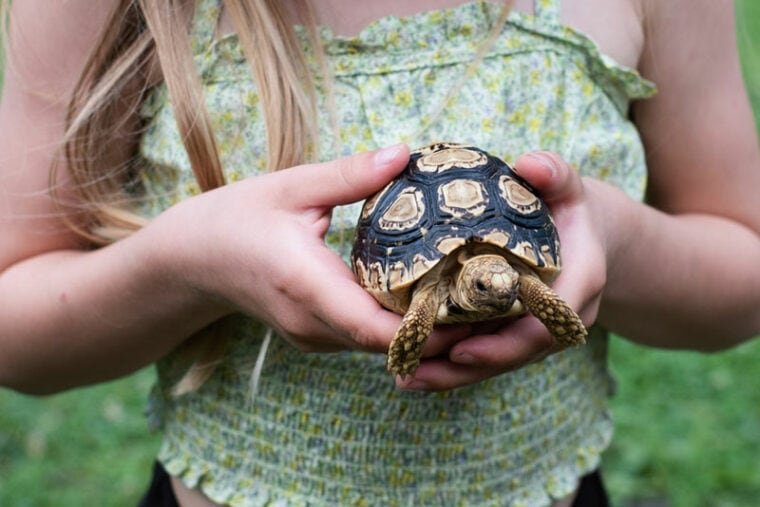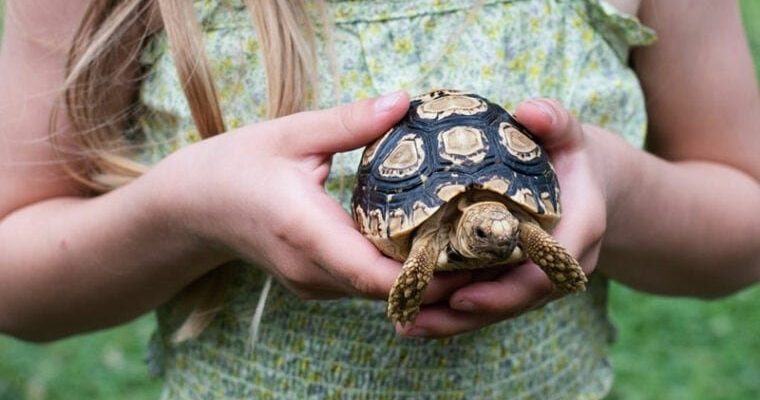
The leopard tortoise, known for its stunning shell patterns and gentle demeanor, can indeed form a bond with their human caregivers. But when it comes to other pets, things get a little trickier. Just like any other pet, their personality can vary. So, let’s dig deeper into the social behavior of these fascinating reptiles and find out how well they mesh with people and other furry (or scaly) friends.
Understanding the Leopard Tortoise’s Behavior
Leopard tortoises are among the larger species of tortoises, with their beautiful markings making them a popular choice for pet owners. But what’s their personality like? First off, these tortoises are generally considered docile. They’re not known for being aggressive, which is great news if you’re looking for a calm companion. However, they can be somewhat shy, especially in new environments. You might find that your tortoise takes time to warm up to you, but once they feel comfortable, their curious side shines through.
You might be wondering how to help them come out of their shell—literally. Creating a safe, engaging environment is key. Make sure their habitat is spacious and enriched with places to hide, explore, and graze. The more comfortable they feel, the more likely they are to show their friendly side!
The Importance of Socialization
Just like puppies or kittens, socialization plays a crucial role in a leopard tortoise’s personality. If they’re not handled gently and regularly, they might remain skittish. Gradually introducing them to your presence can work wonders. Try sitting near their enclosure, talking softly, and offering treats. This helps them associate you with positive experiences, paving the way for a more trusting bond.
It’s important to remember that every tortoise has its own personality. Some might be more adventurous, while others prefer to stick to their routine. Patience is key—much like any relationship, building trust takes time.
Are Leopard Tortoises Good with Humans?
When it comes to interactions with humans, leopard tortoises can be surprisingly affectionate. Their friendly demeanor makes them great pets for families, and many owners report sweet moments with their shelled companions. You may even find your tortoise approaching you for some attention or a tasty snack.
However, while tortoises can learn to recognize their caregivers, they don’t have the same social needs as dogs or cats. They thrive on gentle handling and regular interaction, but don’t expect them to cuddle on the couch like a dog would. Think of them as more of a low-maintenance friend who enjoys your company without needing constant attention.
Handling Your Tortoise
To build a strong bond with your leopard tortoise, handling them properly is essential. Here are a few things to keep in mind:
- Support their body: Always lift your tortoise by supporting their shell and feet.
- Watch for stress signals: If they retreat into their shell or try to run away, give them some space.
- Consistency is key: Regular, gentle handling can help them become accustomed to you.
By treating them with care and respect, you’re more likely to have a loving, friendly companion!
Leopard Tortoises and Other Pets
Now, let’s talk about how leopard tortoises interact with other pets. The answer isn’t straightforward. Generally, leopard tortoises can coexist peacefully with certain pets, but caution is essential. If you have dogs or cats, you’ll want to ensure that they’re safe around your tortoise.
Dogs’ natural curiosity can sometimes lead to excitement that might scare a tortoise. Similarly, cats are known to playfully swipe at anything that moves. It’s best to supervise any interactions and provide a safe space where your tortoise can retreat if needed.
Creating a Safe Environment
To set up a harmonious home for multiple pets, consider these tips:
- Separate spaces: Give each pet their own area where they can feel safe and secure.
- Supervise interactions: Always supervise your tortoise when they’re around dogs or cats.
- Gradual introductions: Introduce pets slowly to help everyone adjust.
With the right precautions, leopard tortoises can happily coexist alongside other pets, allowing for a diverse and vibrant home life.
Health and Stress Considerations
Just like any pet, the health and happiness of your leopard tortoise are closely tied to their environment. Stress can lead to health issues, so it’s crucial to provide them with a calm and secure atmosphere. Sudden changes, such as loud noises or the introduction of new pets, can be overwhelming for them.
If your tortoise seems lethargic or isn’t eating, it might be a sign they’re feeling stressed. Pay attention to their behavior and adjust their space accordingly. This could mean providing more hiding places or ensuring they get enough quiet time away from bustling activity.
Signs of a Happy Tortoise
So, how do you know if your leopard tortoise is content? Here are a few positive signs to look for:
- Active exploration: A happy tortoise will be curious and explore their surroundings.
- Regular eating habits: Maintaining a healthy appetite is a great sign.
- Comfort in your presence: Tortoises that feel safe may come toward you for food or attention.
By keeping an eye on their behavior, you can ensure your tortoise thrives in your care.
In a nutshell, leopard tortoises can be friendly companions for humans and, with careful management, can coexist with other pets. They offer a unique blend of personality and beauty that can enrich your home. While they may not be the most overtly affectionate pets, their quirky behaviors and gentle nature can bring joy to your life.
By understanding their needs and taking steps to create a supportive environment, you can enjoy a rewarding relationship with your leopard tortoise. Remember, patience and care are vital—you’ll find that the bond you build will be well worth the effort!

